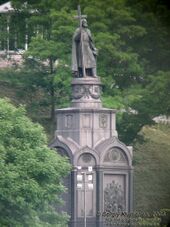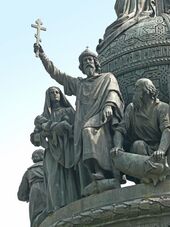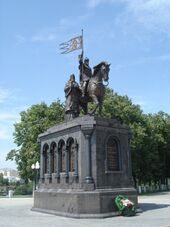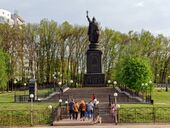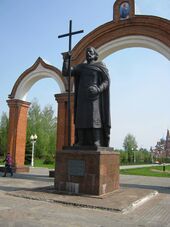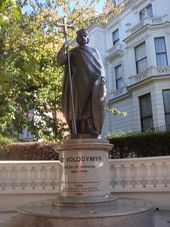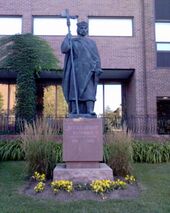ڤلاديمير الأكبر
| Vladimir the Great | |||||
|---|---|---|---|---|---|
 | |||||
| Grand Prince of Kiev | |||||
| Reign | 11 June 978 – 15 July 1015 | ||||
| سبقه | Yaropolk I | ||||
| تبعه | Sviatopolk I | ||||
| Prince of Novgorod | |||||
| العهد | 970 – ح. 988 | ||||
| سبقه | Sviatoslav I | ||||
| تبعه | Vysheslav | ||||
| وُلِد | ح. 958 Budnik near Pskov (modern Pskov Oblast)[2] or Budiatychi (modern Volyn Oblast)[3] | ||||
| توفي | 15 July 1015 (aged approximately 57) Berestove (now in Kyiv) | ||||
| الدفن | |||||
| Spouse |
| ||||
| الأنجال among others | |||||
| |||||
| Dynasty | Rurik | ||||
| الأب | Sviatoslav I of Kiev | ||||
| الأم | Malusha[4] | ||||
| الديانة | Chalcedonian Christianity (from 988) prev. Slavic pagan | ||||
| القديس ڤلاديمير من كييڤ (Saint Volodymyr of Kyiv) | |
|---|---|
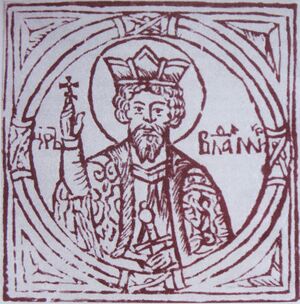 | |
| Equal to the Apostles | |
| وُلِد | ح. 958 |
| توفي | 15 July 1015 |
مكرّم في | Eastern Orthodox Church[5] Catholic Church[6] Anglican Communion Lutheranism[7] |
| عيده | 15 July |
| الصفات | Crown, cross, throne |
ڤلاديمير الأول من كييڤ ( 960 - 1015 ) هو الأمير المعظم في كييف وأحد الأمراء الاسطوريين في بلاد الروس القديمة. وهو من أدخل المسيحية إلى روسيا والذي جعل إمارته أمة مسيحية جديدة تتبع الطائفة الأرثوذكسية
كان فلاديمير الذي يرجع أصله إلى الفايكنج وثنيًا. وفي نحو عام 988م تحول إلى النصرانية، وتزوج من آنا شقيقة الإمبراطور البيزنطي بال الثاني. وقد أسس فلاديمير الأول المدن وبنى الكنائس والمدارس والمكتبات. كذلك نشط التجارة وأقام علاقات حسنة مع البابا والحكام الأوروبيين، كما دافع بقوة عن روسيا ضد جيرانها من الشرق. توفي فلاديمير الأول سنة 1015م، وأعلن قديسًا فيما بعد.
الاسم
Several scholars refer to Vladimir as Volodimer,[8][9][10][11] also spelled Volodimir,[12][أ] and his descendants as Volodimerovichi (sometimes in lieu of "Rurikids").[14][15] In the history of Scandinavia, Vladimir is also known as Valdemar or the Old Norse form Valdamarr (see Waldemar).[16][17][18][19]
ارتقاء العرش
Born in 958, Vladimir was the illegitimate and youngest son of Sviatoslav I of Kiev by his housekeeper Malusha.[20] Malusha is described in the Norse sagas as a prophetess who lived to the age of 100 and was brought from her cave to the palace to predict the future. Malusha's brother Dobrynya was Vladimir's tutor and most trusted advisor. Hagiographic tradition of dubious authenticity also connects his childhood with the name of his grandmother, Olga of Kiev, who was Christian and governed the capital during Sviatoslav's frequent military campaigns.[21]
Transferring his capital to Pereyaslavets, Sviatoslav designated Vladimir ruler of Novgorod the Great in 970,[22] but gave Kiev to his legitimate son Yaropolk. After Sviatoslav's death at the hands of the Pechenegs in 972, a fratricidal war erupted in 977 between Yaropolk and his younger brother Oleg, ruler of the Drevlians; Vladimir fled abroad and assembled a Varangian army to assist him in deposing Yaropolk.[23][24] On his return the next year, he marched against Yaropolk. On his way to Kiev he sent ambassadors to Rogvolod (Norse: Ragnvald), prince of Polotsk, to sue for the hand of his daughter Rogneda (Norse: Ragnhild). The high-born princess refused to affiance herself to the son of a bondswoman (and was betrothed to Yaropolk), so Vladimir attacked Polotsk, took Ragnhild by force, and put her parents to the sword.[20][25] Polotsk was a key fortress on the way to Kiev, and capturing Polotsk and Smolensk facilitated the taking of Kiev in 978, where he slew Yaropolk by treachery and was proclaimed knyaz of all Kievan Rus'.[26][27]
سنوات الحكم الوثني
Vladimir continued to expand his territories beyond his father's extensive domain. In 981, he seized the Cherven towns from the Duchy of Poland; in 981–982, he suppressed a Vyatichi rebellion; in 983, he subdued the Yatvingians; in 984, he conquered the Radimichs; and in 985, he conducted a military campaign against the Volga Bulgars,[28][29] planting numerous fortresses and colonies on his way.[20]
Although Christianity had spread in the region under Oleg's rule, Vladimir had remained a thoroughgoing pagan, taking eight hundred concubines (along with numerous wives) and erecting pagan statues and shrines to gods.[30]
He may have attempted to reform Slavic paganism in an attempt to identify himself with the various gods worshipped by his subjects. He built a pagan temple on a hill in Kiev dedicated to six gods: Perun—the god of thunder and war, a god favored by members of the prince's druzhina (military retinue); Slavic gods Stribog and Dazhd'bog; Mokosh—a goddess representing Mother Nature "worshipped by Finnish tribes"; Khors and Simargl, "both of which had Iranian origins, were included, probably to appeal to the Poliane".[31]
Open abuse of the deities that most people in Rus' revered triggered widespread indignation. A mob killed the Christian Fyodor and his son Ioann (later, after the overall Christianisation of Kievan Rus', people came to regard these two as the first Christian martyrs in Rus', and the Orthodox Church set a day to commemorate them, 25 July[32]). Immediately after the murder of Fyodor and Ioann, early medieval Rus' saw persecutions against Christians, many of whom escaped or concealed their belief.[ب]
However, Prince Vladimir mused over the incident long after, and not least for political considerations. According to the early Slavic chronicle, the Tale of Bygone Years, which describes life in Kievan Rus' up to the year 1110, he sent his envoys throughout the world to assess first-hand the major religions of the time: Islam, Latin Christianity, Judaism, and Byzantine Christianity.[33] They were most impressed with their visit to Constantinople, saying, "We knew not whether we were in Heaven or on Earth ... We only know that God dwells there among the people, and their service is fairer than the ceremonies of other nations."[34]
اعتناقه المسيحية
كان فلاديمير في البداية مثل أبيه يرفض ترك عبادة الأوثان متمسكًا بها لدرجة أنه قام بتشييد معبد لإله الرعد بيرون وكانت تقدم له الذبائح البشرية. وعند عودة فلاديمير إلى مدينته بعد انتصاره في معركة قرر أن يقدم ذبيحة بشرية كشكر للإلهة ووقعت القرعة على أب وابنه مسيحيين هما ثيوذورس ويوحنا. بدأ بعدها في الاهتمام بالدين وبعدم رضائه بالوثنية فبدأ بالبحث في المعتقدات، وقد تردد فلاديمير - بحسب كتاب أخبار نسطور - بين أربعة معتقدات هم الإسلام، أو المسيحيّة الغربيّة، أو الأرثوذكسيّة البيزنطيّة أو اليهودية. فاستدعى فلاديمير كلا من الموفدين اليهود والمسلمين والمسيحيين . فسأل فلاديمير اليهود عما يميز دينهم عن الاديان الاخرى، فقالوا: إلهنا واحد. قال: اين موطنكم ، قالوا: موطننا بعيد، لكن إلهنا بعثرنا في العالم كله لارتكابنا خطايا. ثم سأل فلاديمير المسلمين عما يتصف به دينهم فقالوا : جنتنا بها حوريات. قال: هل يسمح دينكم بشرب الخمر؟ قالو: كلا. قال : راحتنا في خمرنا. وبعدها اختار الأرثوذكسية وتعمد في كييف العاصمة وقتها وكان باسيليوس الثاني الإمبراطور البيزنطي عرّابه. وبعدها أصبحت الأرثوذكسية هي الديانة الرسمية لروسيا منذ عام 989 أو 990. وتعمد سكان كييف في معمودية جماعية بنهر الدنيبر على يد الكهنة اليونانيين الذين رافقوا الأميرة حنة أخت الإمبراطور والتي أصبحت زوجة فلاديمير فيما بعد.
الشهيدان ثيوذورس ويوحنا
بعد أن اعتنق فلاديمير المسيحية قام ببناء كنيسة في المكان الذي مات فيه ثيوذورس وابنه يوحنا كتكفير عن تقديمهما ذبيحة بشرية ونقل أجسادهما إلى الكنيسة. توفي فلاديمير عام 1015 ميلادية.
الطريق إلى العرش
اتفق أبناء سفياتوسلاف الثلاثة بعد موت سفياتوسلاف على تقاسم السلطة، وصار اكبرهم ياروبولك الاول يحكم في كييف، وتولى ثانيهم الحكم في مدينة ايسكوروستين عاصمة قبيلة الدريفليان. اما فلاديمير فتولى الحكم في مدينة نوفغورود. واندلت بعد ذلك الفتنة بينهم. واشتبك اولا الامير اوليغ والامير ياروبولك. فاندحر جيش اوليغ وقتل قائده.
سنوات الحكم الوثنية
كان الامير فلاديمير الاول في البدء وثنيا متعصبا. ثم تحول الى مسيحي امثل بصفته اصلاحيا عظيما في الحياة الدينية للشعب الروسي.
معمودية الروس
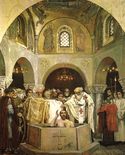


اعجب فلاديمير اخيراً بفخامة الدين البيزنطي المسيجي الارثوذوكسي، فقرر اعتناق المسيحية. ويقول الرواة انه كان يعاني من ضعف البصر فذهب على رأس جيشه ليفتح قلعة كورسون البيزنطية في شمال شبه جزيرة القرم. فسقطت القلعة على ايدي قوات فلاديمير الذي اعتنق بعد ذلك الدين المسيحي وتعافى من مرضه.
وقد قام بتعميد بلاد الروس. وقامت الكنيسة الارثوذكسية الروسية بوضعه في خانة القديسيين فيما بعد. ينتمي الامير فلاديمير الاول الى سلالة روريك.
وتزوج فلاديمر من اميرة بيزنطية. ثم بدأ في تعميد الشعب قسرا. وكان الشعب الروسي خلال فترة طويلة يقاوم اعتناق الدين المسيحي الجديد. وظلت الطقوس والعادات الوثنية تتعايش سوية مع الطقوس المسيحية ، واحتفظ الشعب ببعض الطقوس الوثنية حتى الآن. فمثلا لا يزال الشعب الروسي حتى الآن يحتفل بعيد اسبوع المرافع ( عيد توديع الشتاء واستقبال الشمس) ، او عيد إيفان كوبالا (عيد منتصف الصيف) وغيرهما.
العائلة
يعتبر الامير فلاديمير ابنا للامير سفياتوسلاف والعبدة مالوشا. التي كانت تعمل نادلة للاميرة اولغا. واتفق أبناء سفياتوسلاف الثلاثة بعد موته على تقاسم السلطة. أما أزواجه فكان عدد حريمه يزيد عن 800 زوجة. وكانت جدته لأبيه هي القديسة أولغا التي أخذت اسم هيلانة بعد المعمودية حيث اعتنقت المسيحية حين كانت وصية على العرش سنة 957. أما ابنها سفياتوسلاف أبو فلاديمير فقد رفض اعتناق المسيحية وبقى على الديانة الوثنية وعبادة الآلهة الفايكنغ بالرغم من توسلات أمه ليقبل المعمودية، فقد اعتبرها خيانة عظمى لتقاليد شعبه.
الأهمية التاريخية

قام فلاديمير بتجنيد جيش كبير وضم اليه فريقا من العساكر الاسكندنافيين. وتراجع ياروبول فاستسلم وطلب الرحمة. لكنه قتل على الرغم من استسلامه على ايدي عساكر فلاديمير. وضعفت السلطة في البلاد نتيجة الفتنة. واضطر فلاديمير الى قمع انتفاضات القبائل السلافية مثل قبيلة الفياتيتش وقبيلة الراداميتش وقبيلة الياتفاغ. كما انه اضطر الى خوض الحرب ضد الرحل البيتشينيغ.
وقام فلاديمير بإنشاء خطوط دفاعية على طول نهري ديسنا وأوسيتر وغيرهما من الانهر الواقعة على الحدود الجنوبية للدولة. واستطاع فلاديمير توحيد كل القبائل السلافية الشرقية في دولة واحدة. واطلقت عليها تسمية " كيفسكايا روس" ( روس كييف).
لكن كان لكل قبيلة اصنامها التي تعبدها. وأدرك فلاديمير أن تعدد الآلهة يمنعه من فرض سلطة الدولة المركزية على الجميع. لذلك قرر أولا إنشاء معبد الآلهة الوثنية لكل القبائل السلافية الشرقية على ضفة نهر الدنيبر واختار الاله بيرون إلها رئيسيا. ولكن هذا الامر لم يؤد الى ترسخ التوحيد في البلاد.
Monument to Volodymyr the Great in Kyiv
Vladimir the Great on the Millennium of Russia monument in Novgorod
Monument to Vladimir the Great and the monk Fyodor at Pushkin Park in Vladimir, Russia
St Vladimir the Great Monument in Belgorod, Russia
Monument to Prince Vladimir (Novocheboksarsk)
Statue in London, erected by Ukrainians in Great Britain in 1988 to celebrate the establishment of Christianity in Ukraine by St. Volodymyr in 988
Statue in Toronto erected by Ukrainians in Canada in 1988 to celebrate the establishment of Christianity in Ukraine by St. Volodymyr in 988
وفاته
توفي الامير فلاديمير في 15 يوليو عام 1015 . واثبتت الحفريات التي أجريت في ثلاثينات القرن السابع عشر في مدينة كييف بامر من المطران بيوتر موغيلا اثبتت واقع اغتياله لان تابوته الرخامي احتوى على عظام وجمجمة مبتورة.
انظر أيضاً
- قائمة الحكام الاوكرانيين
- الحياة العائلية وأطفال ڤلاديمير الأول
- قائمة الحكام الروس
- List of people known as The Great
ملاحظات
- ^ According to historian Donald Ostrowski (2017), Russian scholars tend to prefer "Vladimir", while Ukrainian scholars tend to prefer "Volodimer". However, "Volodimir" tends to occur as much in the primary sources as "Volodimer", and significantly more often than "Vladimir".[13]
- ^ In 983, after another of his military successes, Prince Vladimir and his army thought it necessary to sacrifice human lives to the gods. A lot was cast and it fell on a youth, Ioann by name, the son of a Christian, Fyodor. His father stood firmly against his son being sacrificed to the idols. Further, he tried to show the pagans the futility of their faith: "Your gods are just plain wood: it is here now but it may rot into oblivion tomorrow; your gods neither eat, nor drink, nor talk and are made by human hand from wood; whereas there is only one God – He is worshiped by Greeks and He created heaven and earth; and your gods? They have created nothing, for they have been created themselves; never will I give my son to the devils!"[بحاجة لمصدر]
المراجع
- ^ Kevin Alan Brook (2006). The Jews of Khazaria (2nd ed.). Rowman & Littlefield Publishers. p. 154. ISBN 978-1-442203-02-0.
- ^ Александров А. А. Ольгинская топонимика, выбутские сопки и руссы в Псковской земле // Памятники средневековой культуры. Открытия и версии. СПб., 1994. С. 22—31.
- ^ Dyba, Yury (2012). Aleksandrovych V.; Voitovych, Leontii; et al. (eds.). Історично-геогра фічний контекст літописного повідомлення про народження князя Володимира Святославовича: локалізація будятиного села [Historical-geographic figurative context of the chronicled report about the birth of Prince Vladimir Svyatoslavovich: localisation of a busy village] (PDF). Княжа доба: історія і культура [Era of the Princes: history and culture] (in الأوكرانية). Lviv. 6. ISSN 2221-6294. Archived (PDF) from the original on 2022-10-09. Retrieved 7 January 2018.
- ^ Harvard Ukrainian studies, Vol. 12–13, p. 190, Harvard Ukrainian studies, 1990
- ^ Štúr, Ľudovít (June 7, 2021). Slavdom: A Selection of his Writings in Prose and Verse. Glagoslav Publications B.V. ISBN 9781914337031.
- ^ Berit, Ase (March 26, 2015). Lifelines in World History: The Ancient World, The Medieval World, The Early Modern World, The Modern World. Routledge. p. 216. ISBN 9781317466048.
- ^ "Notable Lutheran Saints". Resurrectionpeople.org. Archived from the original on 16 May 2019. Retrieved 16 July 2019.
- ^ Franklin 1991, p. 3.
- ^ Ostrowski 2006, p. 568.
- ^ Halperin 2022, p. 15.
- ^ Dabrowski, Patrice M. (2014). Poland: The First Thousand Years. Cornell University Press. p. 18. ISBN 9781501757402. Retrieved 6 March 2023.
- ^ Ostrowski 2018, p. 33.
- ^ Ostrowski, Donald (2017). Portraits of Medieval Eastern Europe, 900–1400. Christian Raffensperger. Abingdon, Oxon. p. 10. ISBN 978-1-315-20417-8. OCLC 994543451.
{{cite book}}: CS1 maint: location missing publisher (link) - ^ Raffensperger 2016, p. 9.
- ^ Halperin 2022, p. viii.
- ^ Mägi, Marika (15 May 2018). In Austrvegr: The Role of the Eastern Baltic in Viking Age Communication across the Baltic Sea (in الإنجليزية). BRILL. p. 301. ISBN 978-90-04-36381-6.
- ^ Esmark, Kim; Hermanson, Lars; Orning, Hans Jacob (24 January 2020). Nordic Elites in Transformation, c. 1050–1250, Volume II: Social Networks (in الإنجليزية). Routledge. ISBN 978-1-000-03734-0.
- ^ Dʹi͡akonov, Igorʹ Mikhaĭlovich (26 August 1999). The Paths of History (in الإنجليزية). Cambridge University Press. p. 84. ISBN 978-0-521-64398-6.
- ^ Chadwick, H. Munro; Chadwick, Nora K. (31 October 2010). The Growth of Literature (in الإنجليزية). Cambridge University Press. p. 118. ISBN 978-1-108-01615-5.
- ^ أ ب ت Bain 1911.
- ^ Kovalenko, Volodymyr. "Young years of Volodymyr Svyatoslavych: the path to the Kyiv throne in the light of the theories of A. Adler - E. Erikson". Bulletin of the Chernihiv National Pedagogical University. Series: Historical sciences. 2015 (134): 10–18.
- ^ Feldbrugge, Ferdinand J. M. (20 October 2017). A History of Russian Law: From Ancient Times to the Council Code (Ulozhenie) of Tsar Aleksei Mikhailovich of 1649 (in الإنجليزية). BRILL. p. 473. ISBN 978-90-04-35214-8.
- ^ Fennell, John L. (14 January 2014). A History of the Russian Church to 1488 (in الإنجليزية). Routledge. p. 9. ISBN 978-1-317-89720-0.
- ^ Martin, Janet (7 December 1995). Medieval Russia, 980-1584 (in الإنجليزية). Cambridge University Press. pp. 1–2. ISBN 978-0-521-36832-2.
- ^ Levin, Eve (1995). Sex and Society in the World of the Orthodox Slavs 900–1700. Cornell University Press. doi:10.7591/9781501727627. ISBN 978-1-5017-2762-7.
- ^ Den hellige Vladimir av Kiev (~956–1015), Den Katolske Kirke
- ^ Hanak, Walter K. (10 October 2013). The Nature and the Image of Princely Power in Kievan Rus', 980-1054: A Study of Sources (in الإنجليزية). BRILL. p. 15. ISBN 978-90-04-26022-1.
- ^ Janet Martin. Medieval Russia. Cambridge University Press. 1995. pp. 5, 15, 20.
- ^ John Channon, Robert Hudson. The Penguin historical atlas of Russia. Viking. 1995. p. 23.
- ^ "Although Christianity in Kiev existed before Vladimir's time, he had remained a pagan, accumulated about seven wives, established temples, and, it is said, taken part in idolatrous rites involving human sacrifice." (Encyclopædia Britannica)
- ^ Janet, Martin (2007). Medieval Russia, 980–1584 (2nd ed.). Cambridge: Cambridge University Press. p. 6. ISBN 9780511811074. OCLC 761647272.
- ^ "On July 25, the church honors the first holy martyrs of Kievan Rus".
- ^ Bury, John Bagnell (1923). The Cambridge Medieval History. Vol. IV. 308 Cambridge: University Press.
- ^ Thomas Riha (2009). Readings in Russian Civilization, Volume 1: Russia Before Peter the Great, 900–1700. University of Chicago Press. ISBN 9780226718439.
المراجع
- Golden, P.B. (2006) "Rus." Encyclopaedia of Islam (Brill Online). Eds.: P. Bearman, Th. Bianquis, C.E. Bosworth, E. van Donzel and W.P. Heinrichs. Brill.
- تحوي هذه المقالة معلومات مترجمة من الطبعة الحادية عشرة لدائرة المعارف البريطانية لسنة 1911 وهي الآن من ضمن الملكية العامة.
وصلات خارجية
- Velychenko, Stephen, How Valdamarr Sveinaldsson got to Moscow (krytyka.com), 9 November 2015.
Vladimir I of Kiev وُلِد: 958 توفي: 15 July 1015
| ||
| ألقاب ملكية | ||
|---|---|---|
| سبقه ? |
Prince of Novgorod 969–977 |
تبعه ? |
| سبقه Yaropolk I Sviatoslavich |
Grand Prince of Kiev 980–1015 |
تبعه Sviatopolk I |
| ألقاب المطالبة | ||
| سبقه Oleg of the Drevlyans |
Prince of Kiev 977–980 |
تبعه Vysheslav Vladimirovich |
- Articles with unsourced statements from May 2013
- CS1 uses الأوكرانية-language script (uk)
- CS1 الأوكرانية-language sources (uk)
- CS1 maint: location missing publisher
- Short description is different from Wikidata
- Articles with unsourced statements from October 2020
- Articles with hatnote templates targeting a nonexistent page
- مقالات مأخوذة من الطبعة الحادية عشرة لدائرة المعارف البريطانية
- ڤلاديمير الأكبر
- مواليد عقد 950
- وفيات 1015
- تاريخ أوكرانيا
- قديسون اوكرانيون
- قديسون رومان كاثوليك اوكرانيون
- تاريخ روسيا
- قادة روس
- قديسون روس
- قديسون رومان كاثوليك روس
- قديسون أرثوذكس شرقيون
- أسرة روريك
- ملوك أرثوذكس
- قديسون مسيحيون في القرن 11
- Volodimerovichi family
- Ukrainian saints
- Russian saints
- Grand Princes of Kiev
- Rurikids
- Christian monarchs
- 11th-century Christian saints
- 950s births
- 1015 deaths
- Year of birth uncertain
- Christian royal saints
- Princes of Novgorod
- 10th-century princes from Kievan Rus'
- Converts to Christianity from pagan religions
- Burials at the Church of the Tithes


